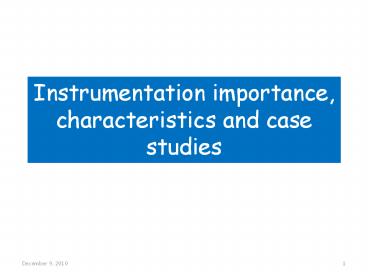Instrumentation importance, characteristics and case studies PowerPoint PPT Presentation
1 / 23
Title: Instrumentation importance, characteristics and case studies
1
Instrumentation importance, characteristics and
case studies
2
Instrumentation importance, characteristics and
case studies
- Presented To
- Dr. Ing- Naveed Ramzan
- Presented By
- Adnan Ali
- 2007-Chem-50
3
Instrumentation importance, characteristics and
case studies
- The advent and rapid growth of automation in
process - industry owes to the demand of precise
measurement - and control.
- This leads to
- economic viability of process
- mass production
4
Importance of Instrumentation
- Measurement is an integral way of interaction
among - humanity and physical world.
- It provides us a dependable and reproducible path
of quantifying the world in which we live. - Instrumentation is done for the sake of
obtaining the required information pertaining to
the completion of a process.
5
Importance of Instrumentation
- The basic variables need to be measured in a
- process plant are
- Temperature
- Pressure
- Level
- Flow rate
- pH
6
Importance of Instrumentation
- Temperature
- The temperature control comes from the
- quality control too.
- In some units like plate type distillation column
- In chemical reactors
7
Importance of Instrumentation
- Pressure
- For the safety of process plant personnel and
- protection of the vessels, and equipments
- Key operations like vapor-liquid equilibrium,
chemical - reaction rate, and fluid flow
- Inferential variable to measure other quantities
like level
8
Importance of Instrumentation
- Level
- Inventory Management
- Continuous supply of materials and
for storage - Control
- For operations like blending, and
mixing and control and stabilization of flow
to the next process units. - Alarming
- High or low limits and safety shut
downs etc. - Data Logging
- For data logging and billing purposes
9
Importance of Instrumentation
- pH
- It is used to measure the acidity or alkalinity
of - liquids
- to measure
- concentration of solutions inferentially.
- As per
- rules of Environmental Protection Agency the
- drinking water, wastes or pollutants coming out
of a - plant should not exceed certain pH level.
10
Importance of Instrumentation
- The importance of instrumentation can be
- summarized as follows
- Production specifications
- Product quality
- Economics
- Operational constraints
- Environmental regulations
- Safety
- Suppressing external influences
11
Performance Characteristics of Instrumentation
- These characteristics are broken down into two
- main categories.
- Static characteristics
- 2. Dynamic characteristics
12
Static Characteristics
- The static characteristic of an instrument
includes - Accuracy
- Precision
- Repeatability
- Reproducibility
- Tolerance
- Range
13
Static Characteristics
- g) Span
- h) Linearity
- i) Sensitivity
- j) Threshold
- k) Resolution
- l) Drift
- m) Hysteresis
- n) Dead Space
14
Dynamic Characteristics
- The dynamic characteristics of an instrument
describe - its behavior between measured quantity changes
and - the time when the instrument output attains a
steady - value in response.
- Such characteristics are
- Speed of response
- Fidelity
- Lag
- Dynamic response
15
Case Studies
16
Bitumen storage tank
17
Case Studies
- Challenge 1
- An asphalt production plant in southwest US have
a - bitumen storage tank. The costumer had been using
a TDR - type (Time dependent reflection) instrument but
they were - not satisfied with the performance. Those
instruments - were not accurate and several needed replacement
- when sensor got caught in the mixer and pulled
out of the - electronics. A combination of delivery
temperatures higher - than 180 C (356 F) and the thick viscous nature
of bitumen - is problematic.
18
Municipal irrigation water distribution
19
Case Studies
- Challenge 2
- Different pumps are used to provide the necessary
- flow required for the distribution system. As the
- different pumps or combination of pumps are used,
- the customer wanted to monitor pump efficiency
- by monitoring the continuous flow in cubic feet
per - second (cfs). The customer was considering a
- magnetic flow meter, but the initial cost for a
- magnetic flow tube that was large enough was
- more than they wanted to spend.
20
Case Studies
- Challenge 3
- An ammonium nitrate fertilizer manufacturer was
- lacking a pH sensor that offered accurate
measurement - in high-temperature inline acid and ammonia
- environments, resulting in under reacted
chemicals with - lower production yields. The extreme process
conditions - resulted in limited lifetime for the sensor
which rarely - exceeded days or weeks in the reactor and only
- functioned for up to a month.
21
PNA 6241/6441-873-10 Inline pH Sensor
22
References
- Books Consulted
- Patranabis, D., Principles of Industrial
Instrumentation, Tata Mc Graw Hill, New Delhi,
2nd Ed., Ch.1. - Survey, W., G. and Andrew, H., B., Applied
Instrumentation in Process Industries, Williams
Gulf Publishing Company, Vol. 1, Ed. 2. - Fribance, A., E., Industrial Instrumentation
Fundamentals, Mc Graw Hill Inc. - Stephanopoulos, G., Chemical Process Control- An
Introduction to Theory and Practice, P T R
Prantice Hall, Englewood Cliffs, New Jersey. - Morris, S., A., Measurement and Instrumentation
Principle, Butterworth Heinemann Publishers, Ch.
2, Pg. 16-21, 2001. - Singh, S., K., Industrial Instrumentation and
Control, Tata Mc Graw Hill Education Private
Limited, New Delhi, Ed. 3, 2009.
23
References
- Web Links
- http//www.scribd.com/doc/38865900/1st-Lec,
retrieved on 13.10.2010 - http//pec.org.pk/sCourse_files/APCS/AppliedProces
sControlSystems.pdf, retrieved on 13.10.2010 - http//water.epa.gov/drink/info/index.cfm,
retrieved on 10.10.2010 - http//fluidinpipe.com/sensors.html, retrieved on
16.10.2010 - http//www.sea.siemens.com/us/internet-dms/ia/Proc
essInstruments/Level/docs_RadarLevel/LR250_Asphalt
_Case_Study_SII.pdf, retrieved on 31.10.2010 - http//www.sea.siemens.com/us/internet-dms/ia/Proc
essInstruments/Level/docs_UltrasonicLevel/Irrigati
onSonokit_CaseStudy.pdf, retrieved on 31.10.2010 - http//www.astisensor.com/Case_Study_1.pdf,
retrieved on 08.10.2010

